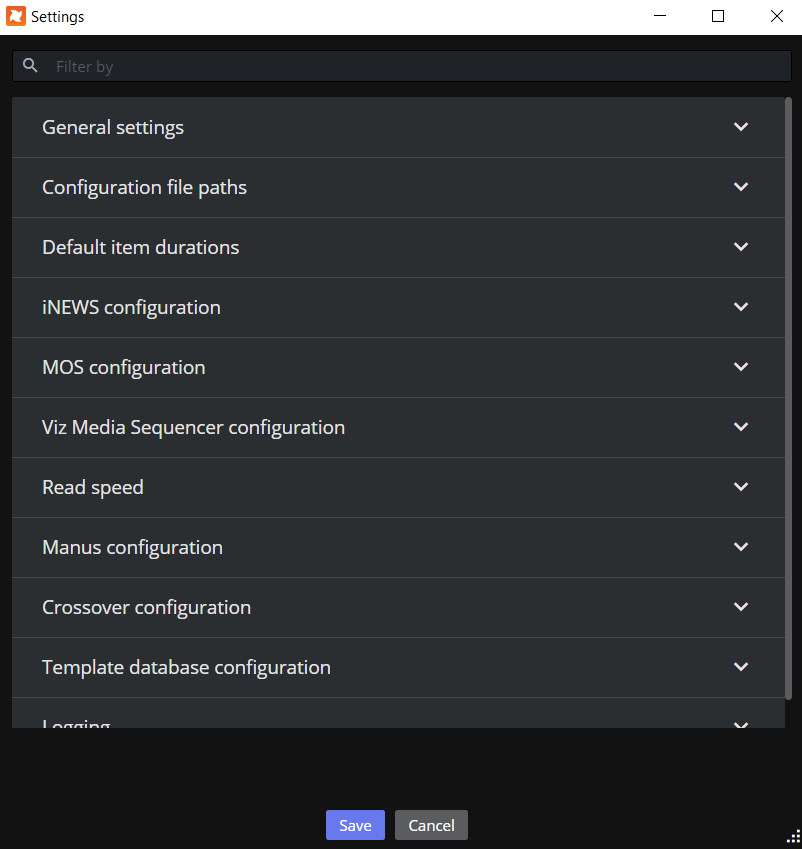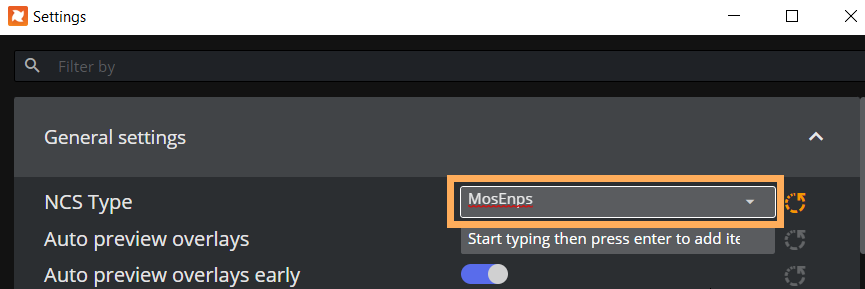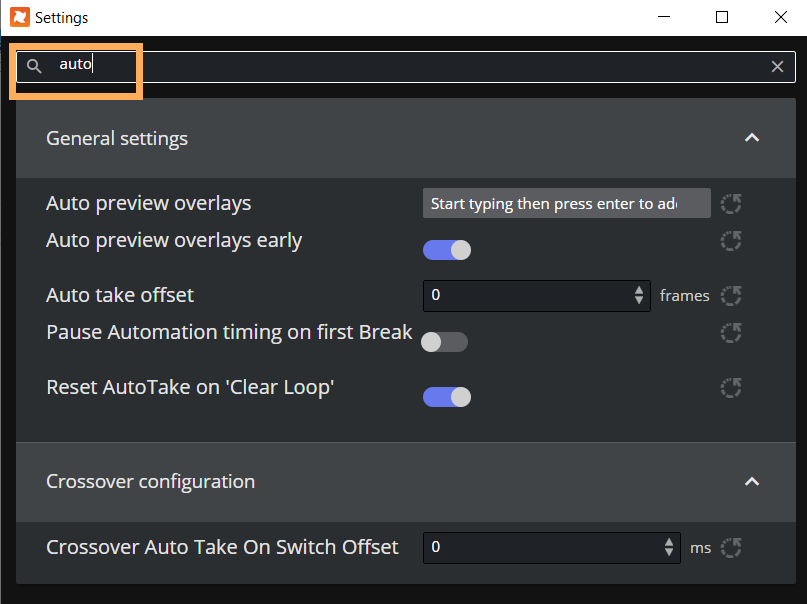
Viz Mosart Administrator Guide
Version 5.5 | Published July 22, 2024 ©
Settings Editor MOS
Working with MOS Settings
To simplify setting up the connection to a MOS-based NRCS, the Manus Admin console includes a Settings utility.
-
Open the Settings utility by typing settings followed by ENTER.

-
From the General settings section, under NCS Type, select the flavor of MOS that the NRCS uses.

Tip:
-
You can search for a specific value from the Search box.

The editor comprises several sections, each dedicated to a collection of settings:
General
-
NRCS Type: Generic: No special handling of native NRCS commands. Can be: Generic, DaletPlus, ENPS, NcPower, Octopus, Open Media and MOSInews.
Default: Generic. -
Auto preview overlays: Lists graphics destinations that support preview of overlay graphics (i.e. DSK enables preview of all overlay graphics with handler=DSK).
Default: Empty = no preview. -
Auto preview overlays early: Enable preview of overlay graphics as early as possible. When set to False, the preview will be displayed only when the graphics is the next item to be taken.
-
Autotake offset: Sets offset for the autotake function.
Default: 0 (milliseconds). -
Default handler name: Defines a default handler name for all graphics that have no handler name.
Default: DSK. -
Default Lower Third out behaviour:
Default: TIMECODE. -
Force clip editorial time: Shows Editorial time in GUI.
Default: False. -
Frame rate: Determines the frame rate of the system. Valid rates 25, 29.97, 50 and 60.
Default: 25. -
Ignore updates if nothing changes: If True , a story update from the NRCS is ignored if the updated story is assumed to be equal to the current version of that story.
Default: False (no NRCS story updates are ignored). -
Keep story status on updates from NRCS: When enabled, keeps played out stories gray if the story is updated in the NRCS.
Default: False. -
Max number of dynamically inserted items: The number of story items that will be inserted and stored dynamically on a Mosart story row. Items can, for example, be inserted with a keyboard shortcut. Default: 0 (all items will be stored).
Note: The greater the number of dynamic items that are kept in a story, the slower the system will become. You will need to verify what performance is acceptable for you, depending on your story properties.
If you experience slowness in the Viz Mosart UI while dynamically taking items into preview or program on a running story, you can try initially changing this value to 5 and then verifying onair performance.
Default value for this setting is 0, which means that behavior of your system will be unchanged, keeping all manual items.
-
For adlibs (floats) this solution introduces a potentially undesirable side effect.
If the adlib is removed from the list of manual items, Viz Mosart will lose the paused position, so that when the adlib is taken again, it will start playing from the beginning instead of from the paused position.
-
-
Metadata creator priority: Select between
-
Newsroom editorial time
-
MAM duration
-
Full video clip length.
-
Separate IDs with commas. Use the name of the Media Administrator entry. Special names are
NCS
(for information from the NRCS) and
GLOBAL
(global values from media object).
If
Empty
, Viz Mosart inserts
NCS
as the first and
GLOBAL
as last entries.
Default:
Empty.
-
Minimum clip length: This value sets the minimum visible length of an offline clip in a story in the GUI. When Viz Mosart receives clip information, the visible length is updated.
Default: 5 (ss:ff). -
Network exclude: Manus Administrator automatically enters idle mode on network failure. This property is a CSV list of network names to ignore when monitoring networks.
Default: Empty (monitor all networks). -
Network include: Manus Administrator automatically enters idle mode on network failure. This property is a CSV list of network names to monitor for network failure.
Default: Empty (monitor all networks) -
Offset secondary events with mix delay: Secondary events follow primary event mix delay. For example, a lower-third element has the same mix delay as the package on which it is to be keyed.
Default: False. -
Pause Automation timing on first Break: When enabled, any first story with a single break template will not start the Automation server rundown timing (Elapsed rundown duration). The timing will start when the next story is taken. This does not affect the NRCS timing.
Default: False. -
Preload Accessory cue delay: Defines the delay between end of cue the next item and execution of a pending preload/pretake accessory. The duration is displayed in frames.
Default: 6 frames, i.e. the accessory preload/pretake functions shall take place after the cue operation is done in AV Automation with an additional and configurable delay of PreloadAccessoryCueDelay frames. -
Reset AutoTake on 'Clear Loop': Enable this to automatically disable the autotake mode when using the clear loop function from the GUI.
Default: True. -
Server description: Used for display only, in Timing Display.
Default: ControlRoom. -
Startup in idle mode: Determines whether or not Manus Administrator is idle at start-up. For standard Viz Mosart operation, this setting shall always be True, so that the Viz Mosart server starts up in Idle mode. Switching between Idle and Active mode shall in normal operation be done from the GUI.
Default: True. -
Story compare ignore attributes: Used for debugging purposes only.
Default: Empty. -
Templates allowing graphic pretake: Lists template types that allow pretake of overlay graphics elements. Available template types: ADLIBPIX, BREAK, CAMERA, DVE, FULLSCREENGRAPHICS, LIVE, PACKAGE, TELEPHONEINTERVIEW, VOICEOVER. Default: PACKAGE, VOICEOVER.
Only the first graphic found on the next item is taken. This graphic is taken immediately regardless of its start time.
Note: To enable graphic pretake, the Pretake overlay on handler setting must be configured in the Newsroom Settings Editor.
-
Use item status to NRCS: Sends online offline CUE/PLAY/STOP status to the NRCS when enabled. Default: False.
-
Ignore Send Cue Status to NRCS for offline clips: When selected, the NRCS will not receive CUED and READY status for offline video clips. Default: Unselected, do not ignore.
-
Refresh media on NRCS update: When selected, triggers a clip refresh for all clips belonging to a story that is being updated. This usually happens through the NRCS story update mechanism. Ensures that all clip information is synchronized. Default: Do not trigger refresh.
-
Time in ms to delay initializing devices while waiting for NRCS to add story: Set to 1200 to avoid traffic overload (blinking whilst loading). Set to 500 to avoid the first story being set till the end of the rundown. Default: 500 ms.
File Paths
-
AV config: The path to the XML-file containing the audio and video mappings defined in the AV Automation application.
Default: c:\channeltemplates\avconfig.xml. -
Channel templates: The path to the file containing the Viz Mosart templates built in the AV Automation Template Editor.
Default: c:\channeltemplates\channeltemplates.xml. -
Manus directory: The path to the folder containing copies of the internal Viz Mosart rundown.
Default: c:\manus -
Newsroom settings: The path to the XML file containing the mappings from newsroom system commands to Viz Mosart templates.
Default: c:\channeltemplates\newsroomsettings.xml.
Default Item Durations
-
Break: The minimum length given to the BREAK template type in the rundown. If no time is given in the NRCS, then this time is given to the element.
Default: 100 (frames). -
Item: The minimum length given to any template type in the rundown. If no time is given in the NRCS, then this time is given to the element.
Default: 100 (frames). -
Camera: The minimum length given to the CAMERA template type in the rundown. If no time is given in the NRCS, then this time is given to the element.
Default: 125 (frames). -
DVE: The minimum length given to the DVE template type in the rundown. If no time is given in the NRCS, then this time is given to the element.
Default: 125 (frames). -
Fullscreen graphic: The minimum length given to the FULLSCREEN GRAPHIC template type in the rundown. If no time is given in the NRCS, then this time is given to the element.
Default: 125 (frames). -
Live: The minimum length given to the LIVE template type in the rundown. If no time is given in the NRCS, then this time is given to the element.
Default: 125 (frames). -
Lower third: The minimum length given to the Lower-third template type in the rundown. If no time is given in the NRCS, then this time is given to the element.
Default: 100 (frames). -
Telephone interview: The minimum length given to the PHONO template type in the rundown. If no time is given in the NRCS, then this time is given to the element.
Default: 125 (frames). -
Video clip: The minimum length given to the CLIP template type in the rundown. If no time is given in the NRCS, then this time is given to the element.
Default: 125 (frames). -
m length given to the CLIP template type in the rundown. If no time is given in the NRCS, this time is given to the element.
-
Default: 125 (frames).
MOS
These settings are used when sending Mosart templates as MOS objects to the NRCS. MOS objects can then, for example be used to create items in a rundown (as an alternative to the legacy Mosart ActiveX implementation).
You can also send a MOS object containing lower-third information.
-
MOS server: IP address or hostname of the main newsroom system’s MOS gateway. See Notes below.
Default: NCSSERVER. -
MOS server backup: IP address or hostname of the backup newsroom system’s MOS gateway. See Notes below.
Default: Empty. -
NRCS ID: Same form as mosID, but this value is the ID for the newsroom system. See Notes below.
Default: NCSSERVER. -
NRCS backup ID: Same form as mosID, but this value is the ID for the backup newsroom system. See Notes below.
Default: Empty. -
MOS ID: MOS identification of this instance of the Manus Administrator. Generic value is mosart.<galleryID>.<stationID>.mos.
Default: mosart.mos. -
Use backup server: Enables an NRCS backup configuration. See Notes below.
Default: False. -
Force MOS protocol version: Protocol version to use for NRCS communication. Default (blank) setting detects the version from the NRCS, otherwise, use a discrete value, for example, 2.8.3.
Default: Empty. -
MOS lower port: The MOS protocol communicates on three ports: lower, upper and top. MosUpperPort is MosLowerPort + 1 and MosTopPort is MosLowerPort + 2.
Default: 10540 -
Mos server timeout: Timeout information for MOS ports. Default: 0.0.0.0.
-
1. NRCS to Mosart lower port: NRCS heartbeat sent to Viz Mosart. If the time between received heartbeats exceeds this value, the connection is displayed as lost. Value=0 means no timeout.
Default: 0 (seconds). -
2. NRCS to Mosart upper port: NRCS heartbeat sent to Viz Mosart. If the time between received heartbeats exceeds this value, the connection is displayed as lost. Value=0 means no timeout.
Default: 0 (seconds). -
3. NRCS to Mosart high port: NRCS heartbeat sent to Viz Mosart. If the time between received heartbeats exceeds this value, the connection is displayed as lost. Value=0 means no timeout.
Default: 0 (seconds). -
4. Mosart to NRCS: Timeout value for an established connection between Viz Mosart and the NRCS. If the time from heartbeat is sent to response is received exceeds this value, the connection is displayed as lost. Value=0 means no timeout.
Default: 0 (seconds).
-
-
MOS server time zone: Used when the time zone is not indicated by the NCS Server. Valid values are Z (meaning UTC) and +/-hh[:mm], where hhand mm are double digit hours and optional minutes.
Default: Z (UTC) unless another value is specified. -
MOS schema: A string used to identify Viz Mosart items in the rundown. Default: http://www.mosartmedialab.no/schema/mositem.dtd.
-
Default ready to air: If the value is true, all MOS active rundowns are assumed to be ready to air.
Default: False. -
Templates to MOS objects:
-
Enabled: Enables sending templates to the NRCS through MOS communication.
Default: Enabled. -
GenerateUniqueObjId: Create a unique identifying name when creating a new MOS Object. The NRCS uses this information to search for and reference the MOS Object.
-
GroupedByType: Enable to send all template types as one MOS object with the variants embedded in the objects. Disable to send all template variants as separate MOS objects.
-
MergedClips: Determines whether PACKAGE and VOICEOVER templates are merged as CLIP templates.
-
SendAllTemplateSets: Sends templates from all template sets to the NRCS when enabled. Disable to send only the default template set.
-
TemplateChangeWanted: Set to true, the NRCS will receive an update whenever a template is changed or deleted.
-
-
Story Scope: Displays either:
-
Single = A single story uses one row in the Viz Mosart GUI.
-
Grouped = A single story may span over multiple rows in the Viz Mosart GUI.
Currently only supported for ENPS stories in Grouped mode that have the same story name but different story segments; these are then treated as the same story in Viz Mosart.
Default: Empty (Single).
-
-
MOS reply with Connection MOS ID: If set, any MOS message sent to the NRCS uses the connection MosId instead of the current mos object ID.
Default: False. -
Min. time between story update: If no update is received from the NRCS within the minimum time stipulated, Viz Mosart forces a story update.
Default: 1000 (milliseconds). -
Item ID generator: Default: Empty.
Mosart generates internal IDs using a combination of rundown, story and item IDs. Some newsroom systems reuse item IDs between story updates. If a new object is inserted before an old object, Viz Mosart will therefore generate the same ID for the new object that the old object had, and the old object will be given a new ID.A custom ID generator can be assigned in Item ID generator.
Value
Description
(Empty)
This is the default value and uses the default ID generator
ItemAndObjectID
This ID generator appends the object ID to the default ID generator. This setting should be used for Dalet Newswire.
-
Ignore initial synchronization: Ignores all roReq on startup when synchronizing with the NRCS.
Default: False. -
Ignore Send Item Status filter: Lists regular expressions used to prevent sending MOS status back to the NRCS.
The regular expressions are matched against MosIds of MOS objects. Set to ‘*’ to disable the sending status for all MOS objects.
Default: Empty (send status for all MOS objects). -
Newsroom tag keep keywords: A comma (or semicolon) separated list of CAPITALIZED words.
For example:KEEP
KEEP,INHERIT
If a newsroom tag value is equal to any of these words, the newsroom tag will be assigned the value of the last Newsroom tag with the same name in the same story.
Default: KEEP.
See Keep Newsroom tag (with the same name) within a story in section Newsroom Tags . If "," (only a comma) is used all newsroomtags will be kept. -
Item status unavailable values: Lists status values used to identify NRCS content as invalid. Content as graphics or clip objects.
Default: NOT_READY, ERROR. -
Video server goto delay on retake: The delay, measured in milliseconds, determining the time taken to position the video server timeline after cueing a pre-roll template for previewing recorded material while Viz Mosart is in Story Recorder mode.
The configuration of this delay takes into account several factors, including clip length, video server response, and network connection, all of which can influence the cueing time.
For further details, see section Story Recorder.
Read Speed
-
Read speed: Number of words read per minute by the anchor. By default, words are defined as the parts of text separated by space characters. See Use character for read speed word below. This is applied to prompter text to determine the duration of an announcement and thus the length of the green camera bar and the green part of the voice-over bar in the Viz Mosart GUI.
Default: 145 (words per minute).
Note: This is a fallback read rate, only used when the NRCS System fails to provide a Read speed of its own. This function can be tested by changing any Read speed=”xx” to Read speed=”” on an item in a local Manus file.
-
Use character for read speed word: If set to True, each character counts as a word when calculating the spoken duration of prompter text, see Read speed above. This can be useful in languages like Chinese and Thai, where the space character is not used to separate words. If False (default), words are separated by space characters.
Default: False.
Viz Media Sequencer
-
NCS server: When Showmaker 1.0 is used as NRCS for Viz Mosart, this is where you configure the host address to the Media Sequencer Engine (MSE) that Showmaker is connected to.
-
MSE Playlist Panel Host: The host address of the Media Sequencer Engine (MSE) used by the MSE Playlist Panel in the Viz Mosart UI
Configure the host address of existing MSE host to activate the MSE Playlist Panel. The Playlist Panel offers users active (touch or click-sensitive) thumbnails of graphics held on an MSE.
The Viz Mosart UI needs this MSE connection defined in order for the user to see the Playlist Panel (View > Floating windows > Playlist Panel). See Viz Mosart User Guide, section Viz Mosart user Interface > MSE Playlist Panel.
Manus
-
Default Manus: This value selects the default rundown to use. The READYTOAIR value selects and uses all rundowns indicated by the newsroom system as ready to air.
Default: READYTOAIR -
Manus expiration time: Number of days to keep Manus Administrator files. Older files (than that number of days) are deleted when Manus Administrator is started.
Default: 60 (files are deleted after 60 days).
Legal values: -1 (never deleted), 1 and above (number of days until deleted from the manus folder). -
Manus keep file pattern: If Manus expiration time is given, this property allows a list of file search patterns for files to keep in the Manus Administrator directory.
Files with names satisfying any of these patterns will be kept even if they are 'too old' according to the Manus expiration timeFor example, "TEST*;DEMO??.xml" keeps all files starting with “TEST” and all DEMO??.xml files where ‘?’ denotes a wild character.
Default: Empty (no files to keep). -
Test manus: Rundown to be used for maintenance purposes.
-
Use the default selection of Manus: Initializes the rundown given in the Default Manus setting automatically when enabled.
Default: True
Crossover
-
Connection string: The connection string of the crossover. For example: controller=IP address, client=crossover.
Default: Empty. -
Crossover autotake on switch offset: Offset in milliseconds to pre-take an autotake when the next story item follows a crossover switch. A positive value triggers the autotake before the given duration of the story item. A negative value triggers the autotake after the given duration of the story item.
Default: 0. -
Crossover SetNext on switch delay: Delay of sending set next story from the server running the show when taking control.
Default: 500 (milliseconds).
Template Database
-
Use template database: When true, enables the Template DB functionality, so template type aliases can be exported from DB to newsroomsettings.xml at startup, and exporting newsroomsettings.xml to DB after saving newsroomsettings.xml.
Default: False.
Note: Enter the Connection string before enabling Use template database.
-
Name of DB provider: The provider name for the Template DB. For example, MySql.Data.MySqlClient for MySQL.
Default: MySql.Data.MySqlClient. -
Connection string: The connection string for the Template DB. For example, for MySQL: server=<hostname>; User Id=<user>;Password=<password>; database=mosarttemplatedb.
Default: server=localhost;User Id=root;database=mosarttemplatedb. -
Default template DB inserter: The name to be used for the insertedby and updatedby columns in the Mosart Template Database.
Default: inserter.
Logging
-
Log level: Sets the detail level of logging to the log file. Normal, Warnings, Errors, Info, Detailed.
Default: 0. -
Log MOS communication: Enable logging of the communication to and from the NRCS.
Default: False. -
In use: Enables or disables the logging of events from the Manus Administrator to the log file.
Default: True. -
WTC Level: Sets the detail level of logging to the console. Error, Message, External message, Details.
Default: Details. -
Trace internally: Enables or disables internal tracing to console, for debugging only.
Default: False. -
Use verbose logging: Enables or disables verbose logging. If In use is set, using verbose the details sent to the log.
Default: False. -
Ignore verbose events filter: Semicolon based list of events to ignore in the log when using verbose logging.
Default: Empty (log all events) -
Pass verbose events filter: Semicolon based list of events to log when using verbose logging.
Default: Empty (log all events) -
MSMQ Log limit: Value to identify when the application should dump the log queue to file. Default: 4023
-
Path for MMLog: The path where the Viz Mosart Log is stored.
Default: MosartLog.
Vizrt Graphics
-
Enable: Allow use of Vizrt graphics
-
MSE Host: The hostname and port number (default 8580) of the MSE used for playout.
-
Playlist name: The name of the MSE playlist where Vizrt content from a Mosart show will be added and made ready for playout.
-
MSE Profile name: Do not change this value.
Notes
-
If there is more than one main newsroom system, the setting parameters MOS server, MOS server backup, NRCS ID, and NRCS backup ID should contain space-separated lists of values, and the values must be in the same order.
-
If some of the newsroom systems do not have a backup system, put them last in the list and leave the corresponding values blank for MOS server backup and NRCS backup ID.
-
If two newsroom systems are backup for each other, both must be listed as both main and backup. If one system is backup for more than one main system, it must be listed as backup for each system.
-
If different newsroom systems need to give Viz Mosart different MOS IDs, the settings parameter MOS ID should also be a space-separated list of values, in the same order as for NRCS ID.
-
Use only a single space between list values. All values are case sensitive.
-
Story Recorder status feedback to the NRCS is supported.